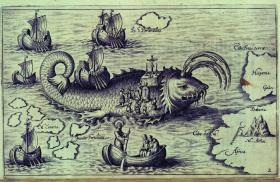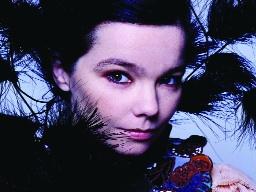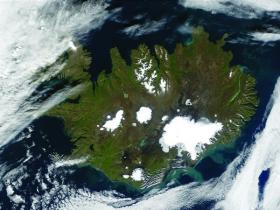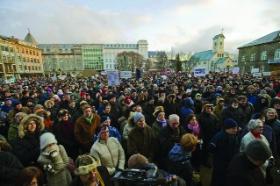The Arctic Irish: fact or fiction?
Published in Features, Issue 3 (May/June 2010), Pre-Norman History, Volume 18
St Brendan and his crew on a whale—from Nova typis transacta navigatio: Novi Orbis India Occidentalis, originally published in 1621 by Honorius Philoponus. The arrival of Irish monks such as St Brendan in Iceland in the eighth century has become accepted in popular history but it remains a subject of some doubt in academic circles. (British Library)
Remote and inaccessible on the edge of the Arctic Circle, Iceland remained uninhabited for centuries after the nomadic hunter-gatherers of mainland Europe and Scandinavia had evolved into settled agrarian communities. Popular legend has it that the first humans to tread the shores and volcanic terrain of Iceland were Christian monks from the north-west of Ireland, in the eighth century.
Upon the demise of the Roman Empire and the subsequent spread of Christianity across Europe, monks and holy men increasingly undertook perilous sea voyages to remote uncharted waters. These expeditions were pilgrimages of sorts, to test their belief in the Lord. Though their faith was clearly not in doubt, one certainly has to question their sanity, setting off into open Atlantic waters in rudimentary craft made of animal hide stretched over a wooden frame. Perhaps the most famous of these reputed journeys is that of the legendary St Brendan, thought to have sailed all the way to the shores of the then-undiscovered Americas. As little or no substantive proof exists to prove that he actually made the voyage, he remains a controversial historical figure. Whether voyaging to America or merely to Iceland, it was in the time long before the existence of navigational equipment or even rudimentary maps, and these brave seafarers had little more than the movements of the clouds and the birds in the sky to guide them on their way. Indeed, it was probably the sighting of migratory Icelandic nesting birds on the Irish skyline, suggesting the possibility of land towards the north, that prompted the first Christian forays into the north Atlantic.
Little or no evidence of original Irish settlement

Rock singer Bjork—an example of the relative abundance of stunningly beautiful women in Iceland? (Iceland Travel)
There is little to suggest that these holy men established any permanent settlements in Iceland. Having initially discovered a stable sea route from Ireland to Iceland, it is believed that they made repeated return journeys over the course of several decades until the arrival of the first Norse settlers c. 870. Shortly after this date the monks had all but vanished from the island, never to return. Just as faith was the determining factor in their arrival, it was, it seems, also pivotal in their departure. Ideologically at odds with their new rabble-rousing pagan Norse neighbours, these devout, solitude-seeking monks simply abandoned the island rather than share it with such boorish heathens. The story of the monks is regularly referred to in potted histories, tourist information packs and internet sites. Even in such established works as The history of Iceland by Gunnar Karlsson the arrival of the monks has become accepted history. Nevertheless, while conclusive archaeological evidence of the presence of monks has been unearthed on the remote Orkney and Shetland Islands, no such proof has ever been found in Iceland and so it remains a subject of some doubt in academic circles.
To gain an alternative perspective on this vexed question I spoke to Marteinn H. Sigur?sson, a research fellow at the Árni Magnússon Institute at the University of Iceland, who pointedly describes existing evidence of the monks’ presence in Iceland as practically worthless in serious academic terms. The evidence rests largely on one written source, the Islendingabok (‘Book of the Islanders’) by Ári fródi ?orgilsson, written between 1122 and 1133, about 250 years after the first Norse settlements. His reference to the papar (Old Norse for Irish monks, clerics or hermits) is confined to one short hagiographical account. ‘It must be remembered that Ári was writing for a Christian hierarchy for whom the story of the monks had great symbolic religious significance and which gave increased legitimacy to the position of Christianity in Icelandic society.’

The diverse origins of the modern Icelandic nation have given rise to intense interest in the exact genetic make-up of the 300,000 souls that currently inhabit this isolated rock on the edge of the Arctic Circle. Even a random straw poll on the streets of Reykjavik would tell you that Icelanders are derived from more than Nordic stock: the pale, pasty yet somehow not quite Nordic complexion, the fierce and fiery shocks of ginger hair that occasionally assail you in the street, and the stark and pointed facial features that contrast with the classic Nordic look. (NASA)
In addition, there are a number of place-names that seemingly refer to the temporary settlement of papar, the most prominent example of which is the island of Papey just off the south-west coast of Iceland. Sigur?sson, in his work ‘Perfectly mamillary’: on breasts, nipples and teats in West Norse toponomy, has developed a very plausible alternative theory. He postulates that ‘several names considered in this paper reflect landscape perceptions from the sea’ and an Old Norse equivalent of Norwegian papp(e)—breast, nipple, teat—could evidently be confused with Old Norse papi—Irish monk, cleric or hermit—(pl. papar). In other words, the word papar might well have referred to the topography of the area rather than its inhabitants. Indeed, in places around Scandinavia that are assumed to be named after papar/monks there exist clearly breast-shaped landscape formations. Sigur?sson is at pains to point out that he is not in the business of disproving the monks’ presence, which he estimates as quite probable, but simply that ‘in the rush to believe and accept what is undeniably an appealing and romantic story, both academics and lay men tend to ignore the dearth of valid evidence that supports it’.
Gaelic Irish influence from the ninth century not in doubt
Whatever about the uncertainties surrounding the Irish arrivals of the eighth century, their pivotal presence in the ninth century is beyond question. The simplified potted version of events, which Icelanders never tire of relating to unsuspecting Irish interlopers, goes something as follows:
Once upon a time in the ninth century, a hardy gang of seafarers put in to land in Ireland. These exiled Vikings from Norway, having fallen foul of their king, had subsequently made voyaging and random scavenging their way of life. After the usual round of liquor and looting they took to the waves once more, carrying off the youngest and most attractive of Irish women as slaves. For many, though not all, of these Vikings and their slaves, Iceland became their eventual home. (According to local Icelandic [usually male] wags, these events account for the relative abundance of stunningly beautiful women in Iceland and their relative scarcity in Ireland!)
Though roughly true in its bare essentials, this account is, of course, a gross simplification of a far longer and more complicated historical process. The boozy Nordic passers-by were, most likely, part and parcel of the first wave of Viking settlements in Ireland that subjugated the native Irish and that began c. 830. By c. 870 this first wave of Norse settlers came under sustained attack from combined native Irish forces and it was only then that increasing numbers of Norse Vikings set out upon the high seas in search of pastures new.
The presence of Celtic stock among the first arrivals in Iceland is confirmed by numerous written references in both the Book of Settlements and the Book of Icelanders. In the former is found a comprehensive list of 400 names, of which at least 60 are distinctly Celtic. Though Irish female slaves were undoubtedly among the entourage of the very first settlers, also included were Irish wives and servants acquired through decades of intermingling and intermarriage with the native Irish. Before these Norse Vikings even set sail for the north Atlantic, part of the Irish element among its number had already become largely integrated. With regard to the actual slaves, it seems likely that these were more numerous among the subsequent waves of settlers, as ever-increasing levels of manpower were needed for the settlement process. One of the most comprehensive works on the subject of the Irish in Iceland is Gaelic influence in Iceland by Gísli Sigurdsson, who astutely surveys, assesses and places in context previous work in the area, combining it with his own perspective on the subject. Sigurdsson suggests that slaves may have comprised as much as 30–40% of the population (a conservative estimate largely borne out by scientific analysis, as we shall see shortly). By the eleventh century slavery was on the decline, and it had all but ceased as a practice by the twelfth century, but not before bestowing on Iceland a rich and varied genetic heritage.
Genetic markers

Banking systems in crisis, a more recent parallel in Irish and Icelandic history. Mass demonstrations in Reykjavik forced the government to resign in January 2009—a sign of things to come in Ireland?
For those not content with anecdotal evidence, a series of scientifically based inquiries have been carried out over the last twenty years or so. Initially such studies came up with some wildly fluctuating conclusions. One study, for example, estimated Scandinavian genetic markers to be found in as many as 86% of the population, while another found the obverse, claiming Celtic genetic markers in as many as 98%. In more recent years, however, considerable advances have been made in this area, the result of pioneering work by Agnar Helgason. A biological anthropologist with the Icelandic genetic research company Decode, Helgason has employed the study of mitochondrial DNA to create a much clearer picture of the rather muddied Icelandic gene pool. Mitochondrial DNA is passed largely unchanged from mother to child and thus may prove the key to unlocking historical patterns of long-term population movements. So what exactly does the research tells us? Helgason is quick to stress the perils of oversimplification:
‘One has to be quite careful about the conclusions one reaches. To simply state, as is sometimes done, that 50 or 60% of Icelanders are Irish is misleading and wrong. What we can say with near 100% certainty is that at the time of the settlements between about 62% and 70% of women in Iceland were of Celtic origin. For men, the figure is about 20%.’
Those of Celtic origin integrated rapidly into what became essentially a Norse civilisation. This begs the obvious question: what, beyond genetics, is the legacy of the Gaelic presence in Iceland? As noted earlier, in terms of archaeology, this legacy is quite scant. The same could also be said in relation to the Icelandic language. According to Gísli Sigurdsson, the limited number of borrowed words may be explained by the fact that the ‘Gaels did not contribute any new work skills or crafts, carrying their own vocabulary into the mainly Norse controlled society’, coupled with the fact that ‘the language of the slaves was probably not widely spoken by their masters’.
Literature
It is, perhaps, in the realm of Icelandic literature that a search for this elusive legacy may bear the most fruit. The jewels in the crown of Icelandic literary tradition are the majestic sagas of the twelfth and thirteenth centuries. Icelandic oral and written traditions of the period were a unique achievement among the Nordic nations and have inevitably given rise to diverging theories to explain the phenomenon. Though some Scandinavian scholars point to circumstances surrounding the settlement of this unique Arctic community and the influence of Continental literary tradition, British and Irish historians, and indeed Sigurdsson himself, tend to argue that the influence of the Gaelic presence in Iceland is a more plausible explanation. In the Gaelic world, oral tradition and the writing of the sagas in the vernacular was highly developed. In fact, ‘Iceland and Ireland were the only countries in Western Europe where sagas of this kind were written down, and this has caused many scholars to assume that there must be some connection between the two’. The exact nature and extent of such a connection remains a matter of conjecture and is impossible to prove conclusively. Such notions do, however, rest on some undeniably striking resemblances in the literary output of Iceland and Ireland during this period. As Terry Gunnell, senior lecturer in Folklore at the University of Iceland, explains, ‘one of the most distinctive similarities that exists is in the realm of the single motif’—that is to say, a parallel between the parable-like plot lines or the specific actions of legendary fictional characters in the literary works of the two nations. According to Gunnell, such parallels encompass everything from leprechaun-like creatures to the ancient Gaelic team game of hurling. ‘Particularly worth looking at is the ancient character of Cú Chulainn, perhaps the most famous warrior in Irish mythology.’ Similarities have been drawn between Cú Chulainn and the character of Starka?r, a stalwart of the Icelandic Fornaldarsogur, popular in the early fourteenth century. Both characters in their respective sagas at one point lie naked in the snow searching their clothes for lice. The trouble, in the case of the Cú Chulainn/Starka?r and other motifs, is deciding with any degree of certainty the direction, if any, in which the literary influence is travelling. Moreover, defining the significance of these literary parallels has proven far more elusive than uncovering the mere fact of their existence.
It could be argued, at least, that Gaelic influence seems a little more clear-cut with regard to the Icelandic family sagas. Sigurdsson successfully identifies sagas that come from the west of the island as having a more powerful Gaelic element than others, which could be explained by the stronger Gaelic presence in this area. The most prominent example of this trend is the saga of the people of Laxardal (Laxdæla saga). In this tale one of the characters, Hoskuldr, obtains a slave woman from Norway who turns out to be Melkorka, daughter of a prominent Irish king. Retaining her native Gaelic language, she secretly passes it on to her son Ólafr, who later travels to Ireland to renew family ties and, despite his lowly slave origins, marries well. His son Kjartan becomes the predominant male hero of the Laxdæla saga. Parallels with the character of Cú Chulainn are again in evidence in a number of the family sagas. Some of his boyhood deeds are mirrored by the character of Kolfi?r in the Kjalnesing saga, and to a lesser extent in Egil’s saga. Parts of these sagas, particularly in the case of Laxdæla saga, tend to have a more colourful, exaggerated style with greater attention to detail, perhaps reflecting the Gaelic predilection for such literary affectations.
In the final analysis, all our resident experts would agree that it is impossible to measure definitively the extent and meaning of Gaelic influence on Icelandic writings, but what can be said with certainty is that a broad understanding of the unique strength of the literary tradition of medieval Iceland cannot be achieved without substantial reference to the Irish connection. HI
A Spanish and politics graduate from Ireland, John Boyce is a freelance writer who divides his time between Madrid and Reykjavik.
Further reading:
G. Karlsson, The history of Iceland (Milwaukee, 2000).
G. Sigurdsson, Gaelic influence in Iceland (Reykjavik, 2000).
M. Sigur?sson, ‘Perfectly mamillary’: on breasts, nipples and teats in West Norse toponomy (Reykjavik, 2002).
















